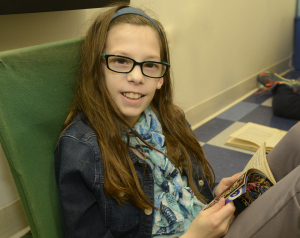Last month, I made a presentation to 4th-8th graders, teachers, staff and my family at JCDS about my physical disability, Multiminicore Myopathy. Multiminicore Myopathy is a very rare hidden disability that affects the muscles and makes them fatigue easily. I was inspired to give this presentation to raise awareness about all physical disabilities and other medical conditions so that the JCDS community’s questions about me could be answered and they could learn how to better support me. Also, the program Understanding Our Differences/Gateways was very inspiring because if total strangers could get up there and talk about their disabilities then I could, too, and the school could relate more to a peer than someone they don’t know personally.

Leading up to the presentation, I was excited! On the day of the presentation, my dad was supposed to bring my motorized scooter and was a little late, but he got there just in time. Speaking in front of almost 100 people was not super intimidating because I had spoken before in front of a much bigger crowd of people I didn’t know. It was very interesting to have the entire middle school learn about me and my condition. I am going to be with and learn with this group of students and teachers for the next three years, so now they really understand and accept my differences. The questions were very interesting to hear because this was a new group of people that had different opinions and wonderings about me. One of the most frequently asked questions was about getting my service dog. Also a question one of my teachers asked that was very helpful was what can people in the JCDS community do to better support me.
I wanted people to walk away with the understanding that people with and without disabilities are all different, some a little more than others. When you have met one person with a disability, you have met that one person—not the whole group. I’ve observed that when you see someone in a wheelchair or with a service dog, just smiling and saying hi really means a lot to them. In addition, I wanted my peers to understand that I am still a kid and I like doing kid things! I don’t want my friends to think I can’t play tag and they shouldn’t ask me; I want them to ask because I almost always will say yes. I have limitations because I can’t run as fast as everyone else, but what matters most is that I can still play. Some things that people can do to better help me are small things like picking up a marker for me, or grabbing my siddur from the shelf, or signing me up for something when everyone runs to the board. These are little things that I can do, but they take up energy that I can use later to play a game or do math work in class. I felt like my classmates and teachers walked away from my presentation with a better sense of what my disability is, how it affects me, and how they can continue to support me in the JCDS community.
This article originally appeared on the Jewish Community Day School (JCDS) blog.
This post has been contributed by a third party. The opinions, facts and any media content are presented solely by the author, and JewishBoston assumes no responsibility for them. Want to add your voice to the conversation? Publish your own post here. MORE
